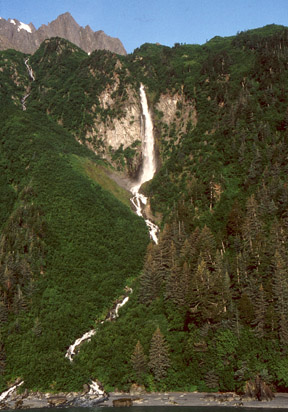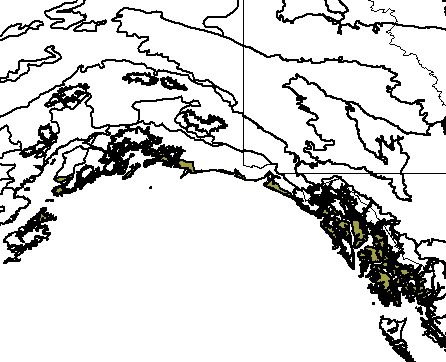
Prince William Sound near Valdez, Alaska (c) 2005 Scott and Ruth Bassett
Bioimages home (click on an image to enlarge)
view
this page in its intended navigation context
Northern Pacific coastal forests
(WWF
ecoregion NA0520)

Prince William Sound near Valdez, Alaska
(c)
2005 Scott and
Ruth Bassett

Source of bioregions data:
Olson, D. M. and
E. Dinerstein. The Global 200: Priority ecoregions for global conservation. (PDF
file) Annals of the Missouri Botanical Garden 89:125-126.
Distinctiveness (1=highest,4=lowest): 1
(globally outstanding)
This ecoregion contains a quarter of the world's temperate rainforests. It
is also one of the most productive in North America. Many species that are
threatened further south are still relatively common here.*
Conservation Status (1=most endangered, 5=most
intact): 4 (relatively stable)
Over 90% of old growth forest remains. However, much of the high volume
old growth forest has either been logged or is scheduled to be harvested in the
near future.*
 | Picea sitchensis | (Sitka spruce) |
 | Tsuga heterophylla | (western hemlock) |
 | Tsuga mertensiana | (mountain hemlock) |
Alnus spp.
Populus trichocarpa (cottonwood)
Betula papyrifera (paper birch)
 | Pinus contorta | (lodgepole pine) |
 | Thuja plicata | (western red cedar) |
 | Chamaecyparis nootkatensis | (Alaska cedar) |
Associated habitats
coastal forest, Prince William Sound, near Valdez, Alaska



(c)
2005 Scott and
Ruth Bassett
hires
hires
hires
riparian area, near Valdez, Alaska


The clean and undammed rivers (left) of this
ecoregion support some of North America's healthiest salmon populations (right).
(c)
2005 Scott and
Ruth Bassett hires
hires
* Ricketts, T.H., E. Dinerstein, D.M. Olson, C.J. Loucks, et al. (1999) Terrestrial Ecoregions of North America: A Conservation Assessment. World Wildlife Fund - United States and Canada. Island Press, Washington, D.C. pp. 199-203.
Except as noted, images copyright 2002-2005 Steve Baskauf - Terms of use